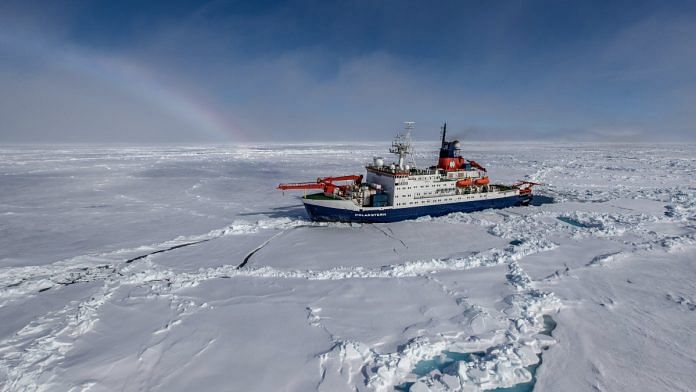New Delhi: Human-driven climate change is causing increased iodine emissions in the Arctic. This, in turn, may be playing a larger role in destroying the ozone layer in the troposphere — the closest atmospheric zone to the surface of the Earth — above the North Pole than previously thought, an international team of researchers has found.
The study, based on observations conducted from March to October 2020 on a research vessel in the high Arctic region, was published in the journal Nature Geoscience on 15 September 2022.
In the stratosphere — the second layer of the atmosphere, above the troposphere — ozone depletion has been reported extensively. However, similar, but shorter-lived, depletion events are also seen closer to the surface of the Earth, in the troposphere.
During these depletion events, ozone concentrations drop to nearly zero. This phenomenon, the subject of the study, is known as springtime tropospheric ozone depletion.
Anoop Mahajan, a scientist at the Indian Institute of Tropical Meteorology in Pune and one of the authors of the study, told ThePrint that halogens — such as bromine, chlorine and iodine — act as catalysts in a reaction that causes the breakdown of ozone (O3) to oxygen (O2).
Ozone depletion events near the earth’s surface were formerly thought to occur mainly because of catalytic depletion by a single type of halogen — bromine, which is emitted into the atmosphere from the Arctic sea-ice region.
Halogen compounds dominate the salt content of seawater. When the water freezes, these salts get separated and form a layer on the top.
But Mahajan explained that it’s specifically bromine salts that get picked up in this form and subsequently interact with the atmosphere.
On the other hand, research has shown that for iodine — naturally present in the ocean — to interact with the atmosphere, the ice caps must first be melted.
“Most of the sea in the Arctic is covered by ice, reducing the iodine emissions in the region. However, with global warming driven by rapid climate change, more and more of the seawater in the Arctic region is exposed to the atmosphere,” Mahajan explained.
Ozone near the earth’s surface then rapidly reacts with the now-exposed iodine on the surface of the sea. These interactions are believed to be the largest single source of gaseous iodine emissions to the atmosphere, which then leads to springtime tropospheric ozone depletion.
Also Read: West Antarctica glacier disintegrating faster than thought
The link to climate change
Using a chemical model, the researchers showed that the chemical reactions between iodine and ozone are the second highest contributor to the loss of surface ozone, after the loss initiated by ozone photolysis (decomposition of molecules caused by light), and ahead of bromine.
This changes a decades-old paradigm on the drivers of Arctic photochemical ozone loss, according to the research team.
With enhanced iodine emissions, as well as the thinning and shrinking of Arctic sea-ice expected in the near future, these results indicate that iodine chemistry could play an increasingly important role in the future. It must be taken into consideration in order to accurately quantify the ozone budget in the Arctic, the study says.
But unlike ozone in the stratosphere — which helps protect the earth from harmful radiation from the sun — ozone in the troposphere is a pollutant that can harm human health.
Asked why, then, the depletion of ozone in the troposphere is of concern, Mahajan explained that every chemical process that takes place is vital to understanding the overall effects of climate change.
“Understanding these chemical reactions will help us build better predictive models that can tell us more about the future with better accuracy,” he said.
(Edited by Theres Sudeep)
Also Read: Japan, Puerto Rico witness torrential rains, massive blackouts as deadly cyclones pound nations



